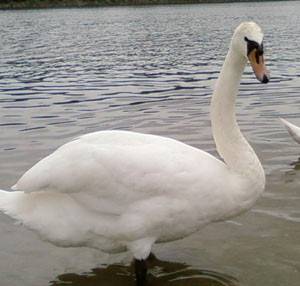 This bird is perhaps one of the most loved and despised birds in North America. Mute Swans were introduced to North America from Europe during the second half of the nineteenth century, and their population has spread throughout the Northeast and Midwest. People introducing the bird wished to add the graceful birds to parks, gardens, and zoos; these birds quickly became feral and spread to native wetlands. Mute Swans’ gracefulness and beauty have made them very popular in urban areas.
This bird is perhaps one of the most loved and despised birds in North America. Mute Swans were introduced to North America from Europe during the second half of the nineteenth century, and their population has spread throughout the Northeast and Midwest. People introducing the bird wished to add the graceful birds to parks, gardens, and zoos; these birds quickly became feral and spread to native wetlands. Mute Swans’ gracefulness and beauty have made them very popular in urban areas.
Mute Swans are one of three swans found in North America. Like all North American Swans, their plumage is predominantly white and they have a long, graceful neck. Mute Swans can be distinguished from native swans, Trumpeter and Tundra, by their orange-and-black bill with a large knob. Mute Swans are not mute; they make a variety of quiet noises, including grunts, hisses, and trumpets. Their wings also whistle in flight. In places where they have been introduced, Mute Swans are often the most common swan; Trumpeter Swans were mostly extirpated from the East, although there is a reintroduction program in place, and Tundra Swans breed in the Arctic and migrate south to the Atlantic and Pacific Coasts.
Mute Swans are highly territorial and aggressive; they often chase away other swans from the water and have even attacked and killed humans. This aggressive behavior appears to have negatively affected swan populations, particularly Tundra Swans, which rely on accessing marshes along the Atlantic Seaboard. Mute Swans have dominated these marshes and prevent flocks of Tundra Swans from stopping to rest and forage. In addition, Mute Swans also consume more aquatic vegetation than other swans, overgrazing and depleting food resources for other waterfowl. In order to control Mute Swans, many states have allowed culls, shooting the birds or destroying their nests in order to restrict the growth of the species. In recent years, the Michigan DNR has started an effort to reduce the number of swans in Michigan from 15,000 to 2,000 in order to benefit native waterfowl populations, particularly the reintroduced (and state endangered) Trumpeter Swan. The cull, though supported by many ecologists, has generated criticism from animal rights groups.
Mute Swans are common along the Chain of Lakes, particularly Portage Lake, where flocks of several hundred congregate in open water during the winter. They feed in areas of shallow water, using their long necks to probe the bottom for aquatic vegetation. They breed in marshes throughout the area, building mound-like nests of reeds and cattails. They lay 1-5 eggs, depending on when they nest; early nesters tend to have larger clutch sizes. The babies, called cygnets, forage with their parents until they can fly, and many stay with their parents through the winter. Juvenile Mute Swans have variable pink-and-black bills and variable brown on the head and neck, which can be confused with Trumpeter Swans; in general, any swan with pink or orange on the bill is most likely Mute.
Mute Swans have inspired many stories in their native Europe and in North America. According to Greek mythology, Cycnus, a prince, grew saddened by the death of his friend and was turned into a swan; other versions of the story state that he was the son of Neptune and was changed once he was slain by Achilles. This led to the Latin name for swans, cygnus. Olor, the species name, is another word for swan, leading to the redundant translation of the scientific name “Swan swan.” Mute Swans are prevalent through the history of Europe as a symbol of light, beauty, and elegance, and they appear in many Celtic, Scandinavian, and Germanic legends.
Further Reading
Click Here for information from All About Birds
Click Here for information from Birds of North America
Click Here for information from the Michigan Breeding Bird Atlas
Click Here for information on the Michigan Swan cull
Click Here for a story on a swan killing a human
Click Here for information on the symbolism of Swans